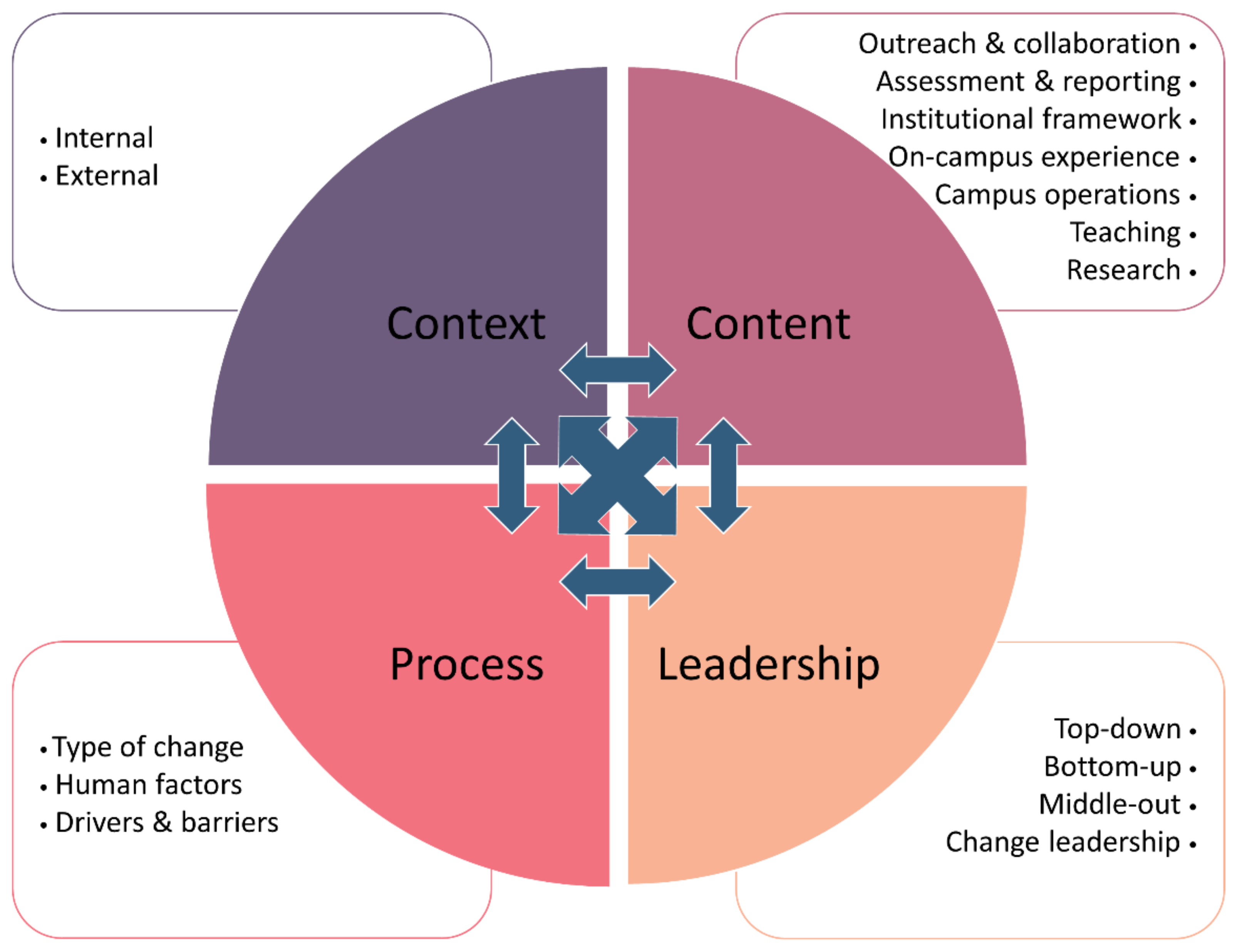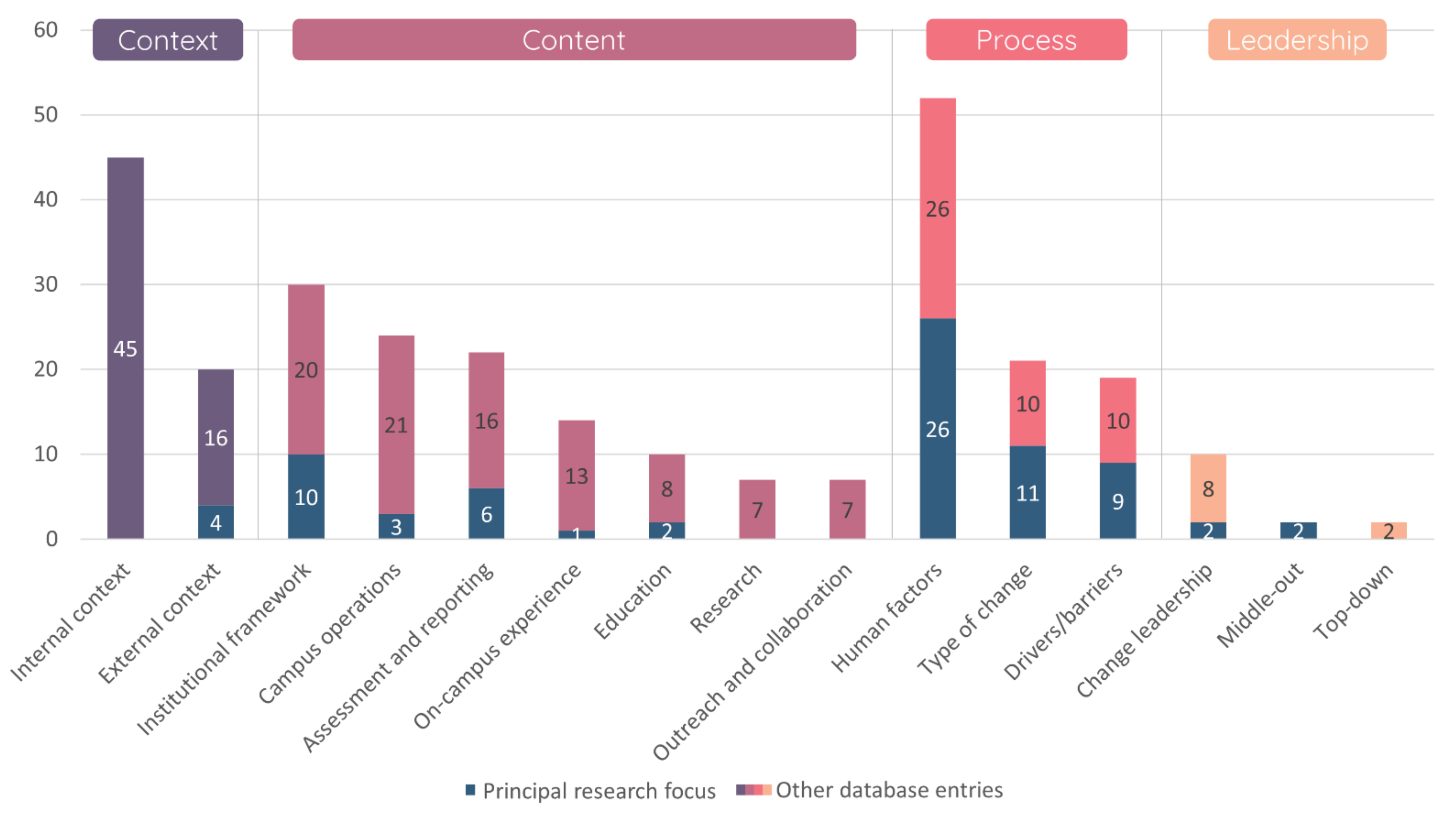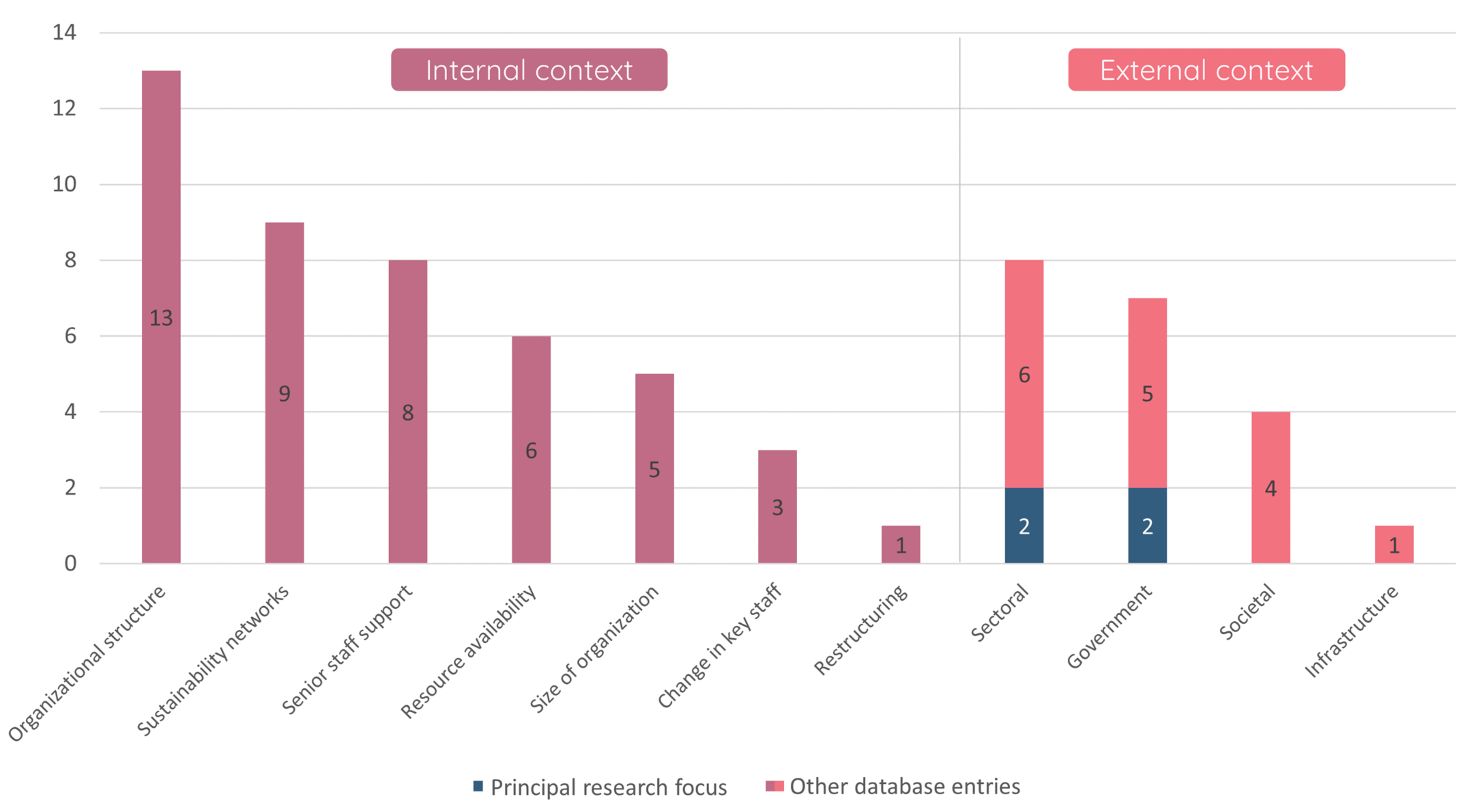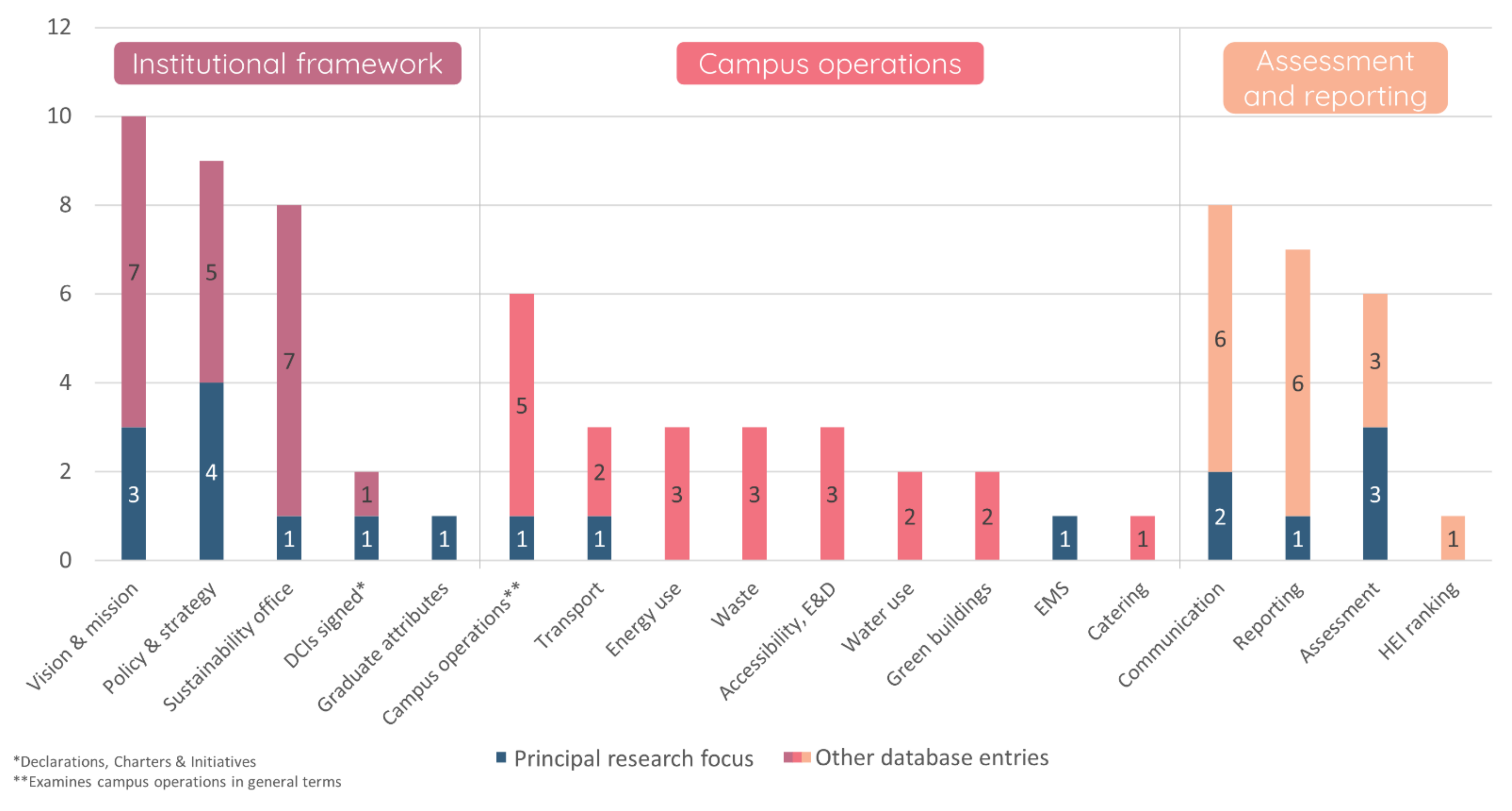Organizational Change Management for Sustainability in Higher Education Institutions: A Systematic Quantitative Literature Review
Abstract
:1. Introduction
2. Theoretical Framework: Studying Organizational Change Management in HEIs
3. Methods
- author(s), journal name, and year of publication;
- geographic scope and scope of analysis;
- research design, the principal research method, and type of data used;
- internal and external context factors (e.g., organizational structure and government);
- content factors constituting:
- ○
- the institutional framework (e.g., policy and strategy);
- ○
- campus operations (e.g., transport);
- ○
- education (e.g., courses on sustainability);
- ○
- research (e.g., research center);
- ○
- outreach and collaboration (e.g., sustainability partnerships);
- ○
- on-campus experience (e.g., engagement);
- ○
- assessment and reporting (e.g., sustainability assessment);
- processes factors related to:
- ○
- human factors (e.g., perceptions);
- ○
- type of change (e.g., pluralistic);
- ○
- drivers and barriers;
- leadership factors (e.g., top-down).
4. Results
4.1. Characteristics of the Literature
4.2. Overview of Change Factors
4.2.1. Context
4.2.2. Content
4.2.3. Process
4.2.4. Leadership
5. Discussion
5.1. Embedding Sustainability in the Institutional Framework
5.2. Pluralistic Approaches to Conceptualize Sustainability
5.3. Building Networks through Assessment and Reporting
5.4. Missing Pieces: Change Context and Leadership
6. Conclusions
7. Limitations
Author Contributions
Funding
Data Availability Statement
Acknowledgments
Conflicts of Interest
Appendix A
| Author(s) | Year | Journal | Principal Research Focus |
|---|---|---|---|
| Agostino and Dal Molin [82] | 2016 | IJSHE | Sustainability conceptualization |
| Akins et al. [44] | 2019 | Sustainability | Drivers and barriers |
| Aleixo et al. [83] | 2018 | IJSHE | Sustainability conceptualization |
| Arroyo [60] | 2017 | J. Clean. Prod | Sustainability assessment |
| Avissar et al. [68] | 2018 | IJSHE | Leadership |
| Awuzie and Abuzeinab [46] | 2019 | Sustainability | Interlinkage of change factors |
| Baker-Shelley et al. [84] | 2020 | International Journal of Sustainable Development and World Ecology | Interlinkage of change factors |
| Barth [26] | 2013 | IJSHE | Types of change |
| Blanco-Portela et al. [47] | 2018 | Sustainability | Drivers and barriers |
| Bien and Sassen [63] | 2020 | J. Clean. Prod | Sustainability conceptualization |
| Bohunovsky et al. [50] | 2020 | Sustainability | Types of change |
| Ceulemans et al. [61] | 2015 | Sustainability | Sustainability reporting |
| Conner et al. [48] | 2018 | Sustainability | Sustainability conceptualization |
| Disterheft et al. [59] | 2012 | J. Clean. Prod | Energy management systems |
| Disterheft et al. [18] | 2015 | J. Clean. Prod | Participatory approaches |
| Dyball et al. [70] | 2015 | Accounting, Auditing & Accountability | Resistance to change |
| Farinha et al. [49] | 2018 | IJSHE | Sector networks |
| Hancock and Nuttman [58] | 2014 | J. Clean. Prod | Sustainable transport |
| Hugé et al. [55] | 2018 | J. Clean. Prod | Types of change |
| Lambrechts [62] | 2015 | Assessment & Evaluation in HE | Sustainability assessment |
| Lambrechts et al. [51] | 2017 | IJSHE | Empowerment |
| Leal Filho et al. [85] | 2017 | Journal of Integrative Environmental Science | Barriers to change |
| Leal Filho et al. [56] | 2018 | IJSHE | Policy |
| Leal Filho et al. [57] | 2019 | J. Clean. Prod | Sustainability offices |
| Leal Filho et al. [69] | 2019 | J. Clean. Prod | Planned change |
| Lee et al. [52] | 2013 | IJSHE | Sustainability in vision |
| Lozano et al. [12] | 2014 | J. Clean. Prod | Sustainability declarations |
| Mahmud et al. [86] | 2019 | International Journal of Innovation, Creativity and Change | Drivers and barriers |
| Niedlich et al. [67] | 2020 | Higher education quarterly | Organizational culture |
| Pollock et al. [54] | 2009 | IJSHE | Sustainability conceptualization |
| Ribeiro et al. [53] | 2016 | IJSHE | Values |
| Schopp et al. [65] | 2020 | Sustainability | Sustainability conceptualization |
| Sylvestre et al. [66] | 2013 | Journal of Education for SD | Sustainability conceptualization |
References
- Orr, D. The Nature of Design: Ecology, Culture and Human Intention; Oxford University Press: Oxford, UK, 2002. [Google Scholar]
- United Nations. Report of the United Nations Conference on Environment and Development Rio Declaration. In Proceedings of the United Nations Conference on Environment and Development, Rio de Janeiro, Brazil, 3–14 June 1992. [Google Scholar]
- The United Nations Environment Programme. Stockholm Declaration on the Environment; The United Nations Environment Programme: Panama City, Panama, 1972. [Google Scholar]
- WBGU World in Transition: A Social Contract for Sustinability; WBGU: Berlin, Germany, 2011.
- Adams, R.; Martin, S.; Boom, K. University culture and sustainability: Designing and implementing an enabling framework. J. Clean. Prod. 2018, 171, 434–445. [Google Scholar] [CrossRef]
- Ramos, T.B.; Caeiro, S.; Van Hoof, B.; Lozano, R.; Huisingh, D.; Ceulemans, K. Experiences from the implementation of sustainable development in higher education institutions: Environmental Management for Sustainable Universities. J. Clean. Prod. 2015, 106, 3–10. [Google Scholar] [CrossRef]
- Newman, J. An organisational change management framework for sustainability. Greener Manag. Int. 2012, 57, 65–75. [Google Scholar] [CrossRef]
- Posner, S.M.; Stuart, R. Understanding and advancing campus sustainability using a systems framework. Int. J. Sustain. High. Educ. 2013, 14, 264–277. [Google Scholar] [CrossRef] [Green Version]
- Stephens, J.C.; Graham, A.C. Toward an empirical research agenda for sustainability in higher education: Exploring the transition management framework. J. Clean. Prod. 2010, 18, 611–618. [Google Scholar] [CrossRef]
- Corcoran, P.B.; Walker, K.E.; Wals, A.E.J. Case studies, make-your-case studies, and case stories: A critique of case-study methodology in sustainability in higher education. Environ. Educ. Res. 2004, 10, 7–21. [Google Scholar] [CrossRef]
- Barth, M.; Rieckmann, M. State of the Art in Research on Higher Education for Sustainable Development. In Routledge Handbook of Higher Education for Sustainable Development; Barth, M., Michelsen, G., Rieckmann, M., Thomas, I., Eds.; Routledge: London, UK, 2016; pp. 100–113. [Google Scholar]
- Lozano, R.; Ceulemans, K.; Alonso-Almeida, M.; Huisingh, D.; Lozano, F.J.; Waas, T.; Lambrechts, W.; Lukman, R.; Hugé, J. A review of commitment and implementation of sustainable development in higher education: Results from a worldwide survey. J. Clean. Prod. 2014, 108, 1–18. [Google Scholar] [CrossRef]
- Pettigrew, A.M.; Whipp, R. Managing Change for Competitive Success; Blackwell Publishing: Oxford, UK, 1991. [Google Scholar]
- Ha, H. Change Management for Sustainability; Business Expert Press LLC.: New York, NY, USA, 2014. [Google Scholar]
- Petticrew, M. Systematic reviews from astronomy to zoology: Myths and misconceptions. Br. Med. J. 2001, 322, 98–101. [Google Scholar] [CrossRef] [Green Version]
- Randolph, J.J. A Guide to Writing the Dissertation Literature Review. Pract. Assess. Res. Eval. 2009, 14, 13. [Google Scholar]
- Moore, J. Seven recommendations for creating sustainability education at the university level: A guide for change agents. Int. J. Sustain. High. Educ. 2005, 6, 326–339. [Google Scholar] [CrossRef]
- Disterheft, A.; Caeiro, S.; Azeiteiro, U.M.; Filho, W.L. Sustainable universities—A study of critical success factors for participatory approaches. J. Clean. Prod. 2015, 106, 11–21. [Google Scholar] [CrossRef]
- Burnes, B. Managing Change: A Strategic Approach to Organisational Dynamics, 4th ed.; Pearson Education: Harlow, UK, 2004. [Google Scholar]
- Doppelt, B. Leading Change Toward Sustainability Change-Management Guide for Business, Government and Civil Society, 2nd ed.; Greenleaf Publishing: Sheffield, UK, 2010. [Google Scholar]
- Exter, N.; Grayson, D.; Maher, R. Facilitating organizational change for embedding sustainability into academia: A case study. J. Manag. Dev. 2013, 32, 319–332. [Google Scholar] [CrossRef]
- Pettigrew, A.M.; Woodman, R.W.; Cameron, K.S. Studying organizational change and development: Challenges for future research. Acad. Manag. J. 2001, 44, 697–713. [Google Scholar] [CrossRef]
- Kuipers, B.S.; Higgs, M.; Kickert, W.; Tummers, L.; Grandia, J.; Van Der Voet, J. The management of change in public organizations: A literature review. Public Adm. 2014, 92, 1–20. [Google Scholar] [CrossRef]
- Kickert, W.J.M. Managing emergent and complex change: The case of Dutch agencification. Int. Rev. Adm. Sci. 2010, 76, 489–515. [Google Scholar] [CrossRef]
- Armenakis, A.; Bedeian, A. Organizational change: A review of theory and research in the 1990s. J. Manage. 1999, 25, 293–315. [Google Scholar] [CrossRef]
- Barth, M. Many roads lead to sustainability: A process-oriented analysis of change in higher education. Int. J. Sustain. High. Educ. 2013, 14, 160–175. [Google Scholar] [CrossRef]
- Parry, K.W. Leadership and organization theory. In The SAGE Handbook of Leadership; Bryman, A., Collinson, D., Grint, K., Jackson, B., Uhl-Bien, M., Eds.; SAGE Publications: London, UK, 2011; pp. 53–70. [Google Scholar]
- Burnes, B.; Hughes, M.; By, R.T. Reimagining organisational change leadership. Leadership 2016, 14, 141–158. [Google Scholar] [CrossRef] [Green Version]
- Parkin, S. The Positive Deviant; Earthscan: Oxon, UK, 2010. [Google Scholar]
- Buller, J.L. From Change Management to Change Leadership: Change Leadership in Higher Education; John Wiley & Sons, Inc.: San Francisco, CA, USA, 2014. [Google Scholar]
- Brinkhurst, M.; Rose, P.; Maurice, G.; Ackerman, J.D. Achieving campus sustainability: Top-down, bottom-up, or neither? Int. J. Sustain. High. Educ. 2011, 12, 338–354. [Google Scholar] [CrossRef]
- Hoover, E.; Harder, M.K. What lies beneath the surface? the hidden complexities of organizational change for sustainability in higher education. J. Clean. Prod. 2015, 106, 175–188. [Google Scholar] [CrossRef] [Green Version]
- Pickering, C.; Byrne, J. The benefits of publishing systematic quantitative literature reviews for PhD candidates and other early-career researchers. High. Educ. Res. Dev. 2014, 33, 534–548. [Google Scholar] [CrossRef] [Green Version]
- Borenstein, M.; Hedges, L.V.; Higgins, J.P.T.; Rothstein, H.R. Introduction to Meta-Analysis; Wiley: London, UK, 2009. [Google Scholar]
- Guitart, D.; Pickering, C.; Byrne, J. Past results and future directions in urban community gardens research. Urban For. Urban Green. 2012, 11, 364–373. [Google Scholar] [CrossRef] [Green Version]
- Steven, R.; Pickering, C.; Guy Castley, J. A review of the impacts of nature based recreation on birds. J. Environ. Manag. 2011, 92, 2287–2294. [Google Scholar] [CrossRef] [PubMed]
- Bettany-Saltikov, J. How to do a Systematic Literature Review in Nursing: A Step-By-Step Guide; Open University Press: Milton Keynes, UK, 2012; ISBN 9780335242283. [Google Scholar]
- Leedy, P.D.; Omrod, J.E. Practical Research: Planning and Design, 10th ed.; Pearson: London, UK, 2010. [Google Scholar]
- Sterling, S. Higher education, sustaiability, and the role of systemic learning. In Higher Education and the Challenge of Sustainability: Problematics, Promise, and Practice; Corcoran, P.B., Wals, A.E.J., Eds.; Kluwer Academic Press: Dordrecht, The Netherlands, 2004; pp. 47–70. [Google Scholar]
- Velazquez, L.; Munguia, N.; Platt, A.; Taddei, J. Sustainable university: What can be the matter? J. Clean. Prod. 2006, 14, 810–819. [Google Scholar] [CrossRef]
- Hallinger, P.; Chatpinyakoop, C. A Bibliometric Review of Research on Higher Education for Sustainable Development, 1998–2018. Sustainability 2019, 11, 2401. [Google Scholar] [CrossRef] [Green Version]
- Pickering, C. Systematic Quantitative Literature Review. Available online: https://www.griffith.edu.au/griffith-sciences/school-environment-science/research/systematic-quantitative-literature-review (accessed on 12 September 2020).
- Moher, D.; Liberati, A.; Tetzlaff, J.; Altman, D.G. Preferred Reporting Items for Systematic Reviews and Meta-Analyses: The PRISMA Statement. PLoS Med. 2009, 6, e1000097. [Google Scholar] [CrossRef] [Green Version]
- Akins, E.E.; Giddens, E.; Glassmeyer, D.; Gruss, A.; Hedden, M.K.; Slinger-Friedman, V.; Weand, M. Sustainability Education and Organizational Change: A Critical Case Study of Barriers and Change Drivers at a Higher Education Institution. Sustainability 2019, 11, 501. [Google Scholar] [CrossRef] [Green Version]
- Verhulst, E.; Lambrechts, W. Fostering the incorporation of sustainable development in higher education. Lessons learned from a change management perspective. J. Clean. Prod. 2015, 106, 189–204. [Google Scholar] [CrossRef]
- Awuzie, B.O.; Abuzeinab, A. Modelling organisational factors influencing sustainable development implementation performance in higher education institutions: An interpretative structural modelling (ISM) approach. Sustainability 2019, 11, 4312. [Google Scholar] [CrossRef] [Green Version]
- Blanco-Portela, N.; R-Pertierra, L.; Benayas, J.; Lozano, R. Sustainability leaders’ perceptions on the drivers for and the barriers to the integration of sustainability in Latin American Higher Education Institutions. Sustainability 2018, 10, 2954. [Google Scholar] [CrossRef] [Green Version]
- Conner, D.; Falkner, A.; Lantieri, N.; McGavisk, B.; McShea, B. Stakeholder Perceptions of Campus Sustainability Efforts: Lessons from Vermont. Sustainability 2018, 10, 3849. [Google Scholar] [CrossRef] [Green Version]
- Farinha, C.S.; Azeiteiro, U.; Caeiro, S.S. Education for sustainable development in Portuguese universities: The key actors’ opinions. Int. J. Sustain. High. Educ. 2018, 19, 912–941. [Google Scholar] [CrossRef]
- Bohunovsky, L.; Radinger-Peer, V.; Penker, M. Alliances of change pushing organizational transformation towards sustainability across 13 universities. Sustainability 2020, 12, 2853. [Google Scholar] [CrossRef] [Green Version]
- Lambrechts, W.; Verhulst, E.; Rymenams, S. Professional development of sustainability competences in higher education: The role of empowerment. Int. J. Sustain. High. Educ. 2017, 18, 697–714. [Google Scholar] [CrossRef]
- Lee, K.-H.; Barker, M.; Mouasher, A. Is it even espoused? An exploratory study of commitment to sustainability as evidenced in vision, mission, and graduate attribute statements in Australian universities. J. Clean. Prod. 2013, 48, 20–28. [Google Scholar] [CrossRef]
- Ribeiro, M.M.; Hoover, E.; Burford, G.; Buchebner, J.; Lindenthal, T. Values as a bridge between sustainability and institutional assessment: A case study from BOKU University. Int. J. Sustain. High. Educ. 2016, 17, 40–53. [Google Scholar] [CrossRef] [Green Version]
- Pollock, N.; Horn, E.; Costanza, R.; Sayre, M. Envisioning helps promote sustainability in academia: A case study at the University of Vermont. Int. J. Sustain. High. Educ. 2009, 10, 343–353. [Google Scholar] [CrossRef]
- Hugé, J.; Mac-Lean, C.; Vargas, L. Maturation of sustainability in engineering faculties—From emerging issue to strategy? J. Clean. Prod. 2018, 172, 4277–4285. [Google Scholar] [CrossRef]
- Leal Filho, W.; Brandli, L.L.; Becker, D.; Skanavis, C.; Kounani, A.; Sardi, C.; Papaioannidou, D.; Paço, A.; Azeiteiro, U.; de Sousa, L.O.; et al. Sustainable development policies as indicators and pre-conditions for sustainability efforts at universities: Fact or fiction? Int. J. Sustain. High. Educ. 2018, 19, 85–113. [Google Scholar] [CrossRef]
- Leal Filho, W.; Will, M.; Salvia, A.L.; Adomssent, M.; Grahl, A.; Spira, F. The role of green and Sustainability Offices in fostering sustainability efforts at higher education institutions. J. Clean. Prod. 2019, 232, 1394–1401. [Google Scholar] [CrossRef]
- Hancock, L.; Nuttman, S. Engaging higher education institutions in the challenge of sustainability: Sustainable transport as a catalyst for action. J. Clean. Prod. 2014, 62, 62–71. [Google Scholar] [CrossRef]
- Disterheft, A.; Ferreira Da Silva Caeiro, S.S.; Ramos, M.R.; De Miranda Azeiteiro, U.M. Environmental Management Systems (EMS) implementation processes and practices in European higher education institutions—Top-down versus participatory approaches. J. Clean. Prod. 2012, 31, 80–90. [Google Scholar] [CrossRef]
- Arroyo, P. A new taxonomy for examining the multi-role of campus sustainability assessments in organizational change. J. Clean. Prod. 2017, 140, 1763–1774. [Google Scholar] [CrossRef]
- Ceulemans, K.; Lozano, R.; Alonso-Almeida, M.M. Sustainability reporting in higher education: Interconnecting the reporting process and organisational change management for sustainability. Sustainability 2015, 7, 8881. [Google Scholar] [CrossRef] [Green Version]
- Lambrechts, W. The contribution of sustainability assessment to policy development in higher education. Assess. Eval. High. Educ. 2015, 40, 801–816. [Google Scholar] [CrossRef]
- Bien, C.; Sassen, R. Sensemaking of a sustainability transition by higher education institution leaders. J. Clean. Prod. 2020, 256. [Google Scholar] [CrossRef]
- Lélé, S.M. Sustainable development: A critical review. World Dev. 1991, 19, 607–621. [Google Scholar] [CrossRef]
- Schopp, K.; Bornemann, M.; Potthast, T. The whole-institution approach at the University of Tubingen: Sustainable development set in practice. Sustainability 2020, 12, 861. [Google Scholar] [CrossRef] [Green Version]
- Sylvestre, P.; Wright, T.; Sherren, K. Exploring Faculty Conceptualizations of Sustainability in Higher Education: Cultural Barriers to Organizational Change and Potential Resolutions. J. Educ. Sustain. Dev. 2013, 7, 223–244. [Google Scholar] [CrossRef]
- Niedlich, S.; Kummer, B.; Bauer, M.; Rieckmann, M.; Bormann, I. Cultures of sustainability governance in higher education institutions: A multi-case study of dimensions and implications. High. Educ. Q. 2020, 74, 373–390. [Google Scholar] [CrossRef] [Green Version]
- Avissar, I.; Alkaher, I.; Gan, D. The role of distributed leadership in mainstreaming environmental sustainability into campus life in an Israeli teaching college: A case study. Int. J. Sustain. High. Educ. 2018, 19, 518–546. [Google Scholar] [CrossRef]
- Leal Filho, W.; Skanavis, C.; Kounani, A.; Brandli, L.L.; Shiel, C.; do Paço, A.; Pace, P.; Mifsud, M.; Beynaghi, A.; Price, E.; et al. The role of planning in implementing sustainable development in a higher education context. J. Clean. Prod. 2019, 235, 678–687. [Google Scholar] [CrossRef]
- Dyball, M.C.; Wang, A.F.; Wright, S. (Dis)engaging with sustainability: Evidence from an Australian business faculty. Account. Audit. Acc. J. 2015, 28, 69–101. [Google Scholar] [CrossRef]
- Menon, S.; Suresh, M. Synergizing education, research, campus operations, and community engagements towards sustainability in higher education: A literature review. Int. J. Sustain. High. Educ. 2020, 21, 1015–1051. [Google Scholar] [CrossRef]
- Wals, A.E.J.; Blewitt, J. Third-wave sustainability in Higher Education: Some (Inter)national Trends and Developments. In Sustainability Education: Perspectives and Practice Across Higher Education; Selby, D., Sterling, S., Eds.; Taylor & Francis Group: London, UK, 2010; pp. 55–74. [Google Scholar]
- Meadows, D. Leverage Points—Places to intervene in a System. Whole Earth 1997, 91, 78–84. [Google Scholar]
- Lewin, K. Group decisions and social change. In Readings in Social Psychology; Newcomb, T.N., Hartley, E.N., Eds.; Holt, Rinehart & Winston: New York, NY, USA, 1947; pp. 459–473. [Google Scholar]
- Rosenbaum, D.; More, E.; Steane, P. Planned organisational change management: Forward to the past? An exploratory literature review. J. Organ. Chang. Manag. 2018, 31, 286–303. [Google Scholar] [CrossRef]
- Yáñez, S.; Uruburu, Á.; Moreno, A.; Lumbreras, J. The sustainability report as an essential tool for the holistic and strategic vision of higher education institutions. J. Clean. Prod. 2019, 207, 57–66. [Google Scholar] [CrossRef]
- Times Higher Education Impact Rankings. 2021. Available online: https://www.timeshighereducation.com/impactrankings#!/page/0/length/25/sort_by/rank/sort_order/asc/cols/undefined (accessed on 12 May 2021).
- Lozano, R. Are companies planning their organisational changes for corporate sustainability? An analysis of three case studies on resistance to change and their strategies to overcome it. Corp. Soc. Responsib. Environ. Manag. 2013, 20, 275–295. [Google Scholar] [CrossRef]
- Ralph, M.; Stubbs, W. Integrating environmental sustainability into universities. High. Educ. 2013, 67, 71–90. [Google Scholar] [CrossRef]
- Wals, A.E.J. Sustainability in higher education in the context of the un DESD: A review of learning and institutionalization processes. J. Clean. Prod. 2014, 62, 8–15. [Google Scholar] [CrossRef]
- Hamel, E. The dominance of English in the international scientific periodical literature and the future of language use in science. AILA Rev. 2007, 20, 53–71. [Google Scholar] [CrossRef]
- Agostino, D.; Dal Molin, M. A grid approach to managing sustainability: Evidence from a multiple Italian case study. Int. J. Sustain. High. Educ. 2016, 17, 875–894. [Google Scholar] [CrossRef]
- Aleixo, A.M.; Leal, S.; Azeiteiro, U.M. Conceptualization of sustainable higher education institutions, roles, barriers, and challenges for sustainability: An exploratory study in Portugal. J. Clean. Prod. 2018, 172, 1664–1673. [Google Scholar] [CrossRef]
- Baker-Shelley, A.; Van Zeijl-Rozema, A.; Martens, P. Pathways of organisational transformation for sustainability: A university case-study synthesis presenting competencies for systemic change & rubrics of transformation. Int. J. Sustain. Dev. World Ecol. 2020, 27, 687–708. [Google Scholar] [CrossRef]
- Leal Filho, W.; Wu, Y.C.J.; Brandli, L.L.; Avila, L.V.; Azeiteiro, U.M.; Caeiro, S.; Madruga, L.R. Identifying and overcoming obstacles to the implementation of sustainable development at universities. J. Integr. Environ. Sci. 2017, 14, 93–108. [Google Scholar] [CrossRef]
- Mahmud, S.N.D.; Nasri, N.M.; Abdullah, S.I.S.S. A whole-of-university approach towards sustainability in a research institute: A force-field analysis. Int. J. Innov. Creat. Chang. 2019, 7, 120–134. [Google Scholar]






| Inclusion/Exclusion Criteria | Number of Papers Excluded | % of Papers Excluded |
|---|---|---|
| Quality | 48 | 65.8% |
| Whole-institution approach | 14 | 19.2% |
| Org. change approach | 9 | 12.3% |
| HEI focus | 2 | 2.7% |
| Total excluded | 73 | 100% |
| Category | Number of Papers | % of Total |
|---|---|---|
| Total | 33 | 100% |
| Year of publication | ||
| 1st 6 years (2005–2010) | 1 | 3.0% |
| 2nd 5 years (2011–2015) | 10 | 30.3% |
| 3rd 5 years (2016–2020) | 22 | 66.7% |
| Journal published in | ||
| IJSHE | 10 | 30.3% |
| Journal of Cleaner Production | 9 | 27.3% |
| Sustainability | 7 | 21.2% |
| Other | 7 | 21.2% |
| Geographic scope | ||
| Local | 13 | 39.4% |
| National | 9 | 27.3% |
| International | 11 | 33.3% |
| Scope of analysis | ||
| Sub-system | 7 | 21.2% |
| Organization | 25 | 75.7% |
| Sector | 1 | 3.0% |
| Research design | ||
| Case study | 12 | 36.4% |
| Multiple case study | 7 | 21.2% |
| Cross-sectional | 10 | 30.3% |
| Exploratory | 4 | 12.1% |
| Principal research method | ||
| Interviews | 15 | 45.4% |
| Survey | 13 | 39.4% |
| Focus groups | 2 | 6.1% |
| Document analysis | 2 | 6.1% |
| Workshop | 1 | 3.0% |
| Data type | ||
| Qualitative | 20 | 60.6% |
| Quantitative | 5 | 15.2% |
| Mixed | 8 | 24.2% |
Publisher’s Note: MDPI stays neutral with regard to jurisdictional claims in published maps and institutional affiliations. |
© 2021 by the authors. Licensee MDPI, Basel, Switzerland. This article is an open access article distributed under the terms and conditions of the Creative Commons Attribution (CC BY) license (https://creativecommons.org/licenses/by/4.0/).
Share and Cite
Rieg, N.A.; Gatersleben, B.; Christie, I. Organizational Change Management for Sustainability in Higher Education Institutions: A Systematic Quantitative Literature Review. Sustainability 2021, 13, 7299. https://0-doi-org.brum.beds.ac.uk/10.3390/su13137299
Rieg NA, Gatersleben B, Christie I. Organizational Change Management for Sustainability in Higher Education Institutions: A Systematic Quantitative Literature Review. Sustainability. 2021; 13(13):7299. https://0-doi-org.brum.beds.ac.uk/10.3390/su13137299
Chicago/Turabian StyleRieg, Nicola Andreij, Birgitta Gatersleben, and Ian Christie. 2021. "Organizational Change Management for Sustainability in Higher Education Institutions: A Systematic Quantitative Literature Review" Sustainability 13, no. 13: 7299. https://0-doi-org.brum.beds.ac.uk/10.3390/su13137299






